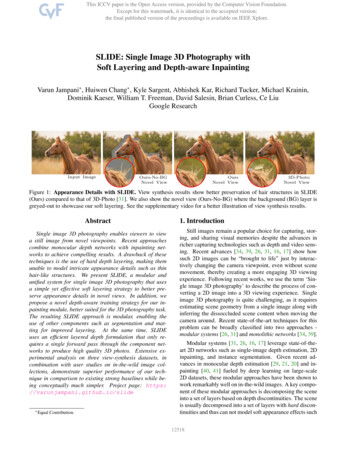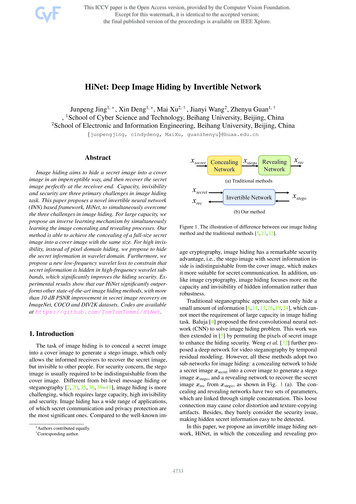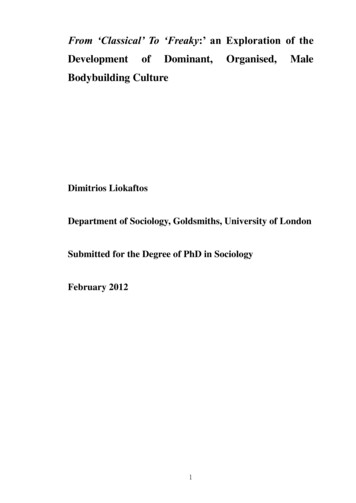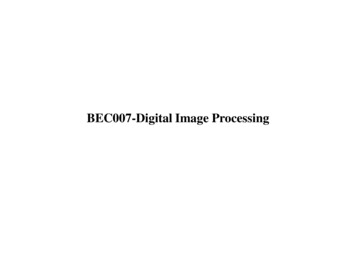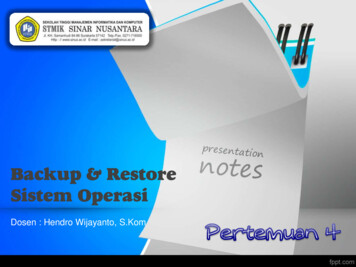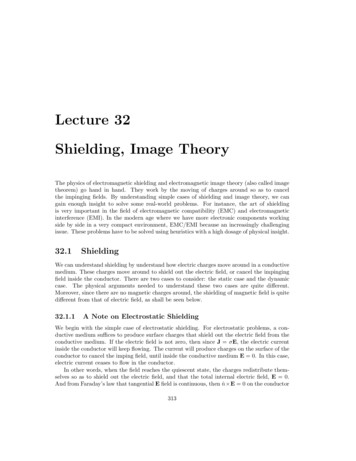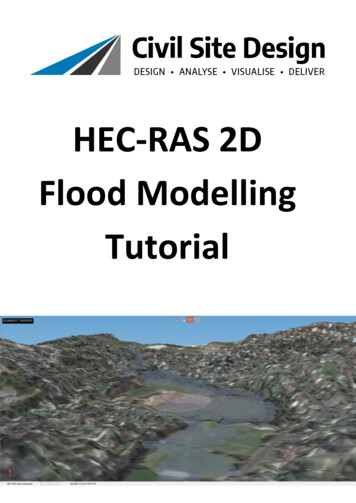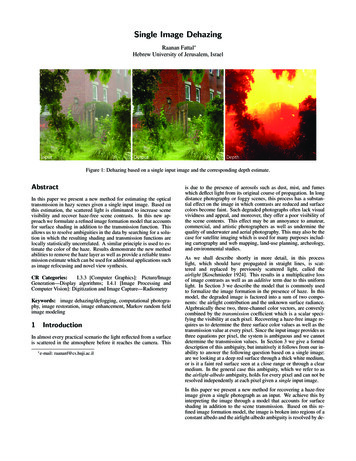
Transcription
Single Image DehazingRaanan Fattal Hebrew University of Jerusalem, IsraelInputOutputDepthFigure 1: Dehazing based on a single input image and the corresponding depth estimate.AbstractIn this paper we present a new method for estimating the opticaltransmission in hazy scenes given a single input image. Based onthis estimation, the scattered light is eliminated to increase scenevisibility and recover haze-free scene contrasts. In this new approach we formulate a refined image formation model that accountsfor surface shading in addition to the transmission function. Thisallows us to resolve ambiguities in the data by searching for a solution in which the resulting shading and transmission functions arelocally statistically uncorrelated. A similar principle is used to estimate the color of the haze. Results demonstrate the new methodabilities to remove the haze layer as well as provide a reliable transmission estimate which can be used for additional applications suchas image refocusing and novel view synthesis.CR Categories:I.3.3 [Computer Graphics]: Picture/ImageGeneration—Display algorithms; I.4.1 [Image Processing andComputer Vision]: Digitization and Image Capture—RadiometryKeywords: image dehazing/defogging, computational photography, image restoration, image enhancement, Markov random fieldimage modeling1IntroductionIn almost every practical scenario the light reflected from a surfaceis scattered in the atmosphere before it reaches the camera. This e-mail:raananf@cs.huji.ac.ilis due to the presence of aerosols such as dust, mist, and fumeswhich deflect light from its original course of propagation. In longdistance photography or foggy scenes, this process has a substantial effect on the image in which contrasts are reduced and surfacecolors become faint. Such degraded photographs often lack visualvividness and appeal, and moreover, they offer a poor visibility ofthe scene contents. This effect may be an annoyance to amateur,commercial, and artistic photographers as well as undermine thequality of underwater and aerial photography. This may also be thecase for satellite imaging which is used for many purposes including cartography and web mapping, land-use planning, archeology,and environmental studies.As we shall describe shortly in more detail, in this processlight, which should have propagated in straight lines, is scattered and replaced by previously scattered light, called theairlight [Koschmieder 1924]. This results in a multiplicative lossof image contrasts as well as an additive term due to this uniformlight. In Section 3 we describe the model that is commonly usedto formalize the image formation in the presence of haze. In thismodel, the degraded image is factored into a sum of two components: the airlight contribution and the unknown surface radiance.Algebraically these two, three-channel color vectors, are convexlycombined by the transmission coefficient which is a scalar specifying the visibility at each pixel. Recovering a haze-free image requires us to determine the three surface color values as well as thetransmission value at every pixel. Since the input image provides usthree equations per pixel, the system is ambiguous and we cannotdetermine the transmission values. In Section 3 we give a formaldescription of this ambiguity, but intuitively it follows from our inability to answer the following question based on a single image:are we looking at a deep red surface through a thick white medium,or is it a faint red surface seen at a close range or through a clearmedium. In the general case this ambiguity, which we refer to asthe airlight-albedo ambiguity, holds for every pixel and can not beresolved independently at each pixel given a single input image.In this paper we present a new method for recovering a haze-freeimage given a single photograph as an input. We achieve this byinterpreting the image through a model that accounts for surfaceshading in addition to the scene transmission. Based on this refined image formation model, the image is broken into regions of aconstant albedo and the airlight-albedo ambiguity is resolved by de-
riving an additional constraint that requires the surface shading andmedium transmission functions to be locally statistically uncorrelated. This requires the shading component to vary significantlycompared to the noise present in the image. We use a graphicalmodel to propagate the solution to pixels in which the signal-tonoise ratio falls below an admissible level that we derive analytically in the Appendix. The airlight color is also estimated usingthis uncorrelation principle. This new method is passive; it does notrequire multiple images of the scene, any light-blocking based polarization, any form of scene depth information, or any specializedsensors or hardware. The new method has the minimal requirementof a single image acquired by an ordinary consumer camera. Alsoit does not assume the haze layer to be smooth in space, i.e., discontinuities in the scene depth or medium thickness are permitted.As shown in Figure 1, despite the challenges this problem poses,this new method achieves a significant reduction of the airlight andrestores the contrasts of complex scenes. Based on the recoveredtransmission values we can estimate scene depths and use them forother applications that we describe in the Section 8.nism, based on the transmission, for suppressing the noise amplification involved with dehazing. A user interactive tool for removingweather effects is described in [Narasimhan and Nayar 2003]. Thismethod requires the user to indicate regions that are heavily affectedby weather and ones that are not, or to provide some coarse depthinformation. In [Nayar and Narasimhan 1999] the scene structure isestimated from multiple images of the scene with and without hazeeffects under the assumption that the surface radiance is unchanged.This papers is organized as follows. We begin by reviewing existingworks on image restoration and haze removal. In Section 3 wepresent the image degradation model due to the presence of hazein the scene, and in Section 4 we present the core idea behind ournew approach for the restricted case of images consisting of a singlealbedo. We then extend our solution to images with multi-albedosurfaces in Section 6, and report the results in Section 8 as well ascompare it with alternative methods. In Section 9 we summarizeour approach and discuss its limitations.Atmospheric haze effects also appear in environmental photography based on remote sensing systems. A multi-spectral imagingsensor called the Thematic Mapper is installed on the Landsatssatellites and captures six bands of Earth’s reflected light. Theresulting images are often contaminated by the presence of semitransparent clouds and layers of aerosol that degrade the qualityof these readings. Several image-based strategies are proposed toremove these effects. The dark-object subtraction [Chavez 1988]method subtracts a constant value, corresponding the darkest object in the scene, from each band. These values are determinedaccording to the offsets in the intensity histograms and are pickedmanually. This method also assumes a uniform haze layer acrossthe image. In [Zhang et al. 2002] this process is automated and refined by calculating a haze-optimized transform based on two of thebands that are particularly sensitive to the presence of haze. In [Duet al. 2002] haze effects are assumed to reside in the lower partof the spatial spectrum and are eliminated by replacing the data inthis part of the spectrum with one taken from a reference haze-freeimage.2Previous WorkIn the context of computational photography there is an increasingfocus on developing methods that restore images as well as extracting other quantities at minimal requirements in terms of input data,user intervention, and sophistication of the acquisition hardware.Examples are recovery of an all-focus image and depth map using asimple modification to the camera’s aperture in [Levin et al. 2007].A similar modification is used in [Veeraraghavan et al. 2007] to reconstruct the 4D light field of a scene from a 2D camera. Given twoimages, one noisy and the other blurry, a deblurring method witha reduced amount of ringing artifacts is described in [Yuan et al.2007]. Resolution enhancement with native-resolution edge sharpness based on a single input image is described in [Fattal 2007].In [Liu et al. 2006] intensity-dependent noise levels are estimatedfrom a single image using Bayesian inference.Image dehazing is a very challenging problem and most of the papers addressing it assume some form of additional data on top of thedegraded photograph itself. In [Tan and Oakley 2000] assuming thescene depth is given, atmospheric effects are removed from terrainimages taken by a forward-looking airborne camera. In [Schechner et al. 2001] polarized haze effects are removed given two photographs. The camera must be identically positioned in the sceneand an attached polarization filter is set to a different angle for eachphotograph. This gives images that differ only in the magnitudeof the polarized haze light component. Using some estimate forthe degree of polarization, a parameter describing this difference inmagnitudes, the polarized haze light is removed. In [Shwartz et al.2006] this parameter is estimated automatically by assuming thatthe higher spatial-bands of the direct transmission, the surface radiance reaching the camera, and the polarized haze contribution areuncorrelated. We use a similar but more refined principle to separate the image into different components. These methods removethe polarized component of the haze light and provide impressiveresults. However in situations of fog or dense haze the polarizedlight is not the major source of the degradation and may also be tooweak as to undermine the stability of these methods. In [Schechnerand Averbuch 2007] the authors describe a regularization mecha-In [Oakley and Bu 2007] the airlight is assumed to be constant overthe entire image and is estimated given a single image. This is donebased on the observation that in natural images the local samplemean of pixel intensities is proportional to the standard deviation.In a very recent work [Tan 2008] image contrasts are restored froma single input image by maximizing the contrasts of the direct transmission while assuming a smooth layer of airlight. This methodgenerates compelling results with enhanced scene contrasts, yetmay produce some halos near depth discontinuities in scene.General contrast enhancement can be obtained by tonemappingtechniques. One family of such operators depends only on pixelsvalues and ignores the spatial relations. This includes linear mapping, histogram stretching and equalization, and gamma correction,which are all commonly found in standard commercial image editing software. A more sophisticated tone reproduction operator isdescribed in [Larson et al. 1997] in the context of rendering highdynamic range images. In general scenes, the optical thickness ofhaze varies across the image and affects the values differently ateach pixel. Since these methods perform the same operation acrossthe entire image, they are limited in their ability to remove the thehaze effect. Contrast enhancement that amplifies local variations inintensity can be found in different techniques such as the Laplacianpyramid [Rahman et al. 1996], wavelet decomposition [Lu and Jr.1994], single scale unsharp-mask filter [Wikipedia 2007], and themulti-scale bilateral filter [Fattal et al. 2007]. As mentioned earlierand discusses below, the haze effect is both multiplicative as wellas additive since the pixels are averaged together with a constant,the airlight. This additive offset is not properly canceled by theseprocedures which amplify high-band image components in a multiplicative manner.Photographic filters are optical accessories inserted into the opticalpath of the camera. They can be used to reduce haze effects as theyblock the polarized sunlight reflected by air molecules and othersmall dust particles. In case of moderately thick media the electricfield is re-randomized due to multiple scattering of the light limitingthe effect of these filters [Schechner et al. 2001].
3Image Degradation ModelLight passing through a scattering medium is attenuated along itsoriginal course and is distributed to other directions. This processis commonly modeled mathematically by assuming that along shortdistances there is a linear relation between the fraction of light deflected and the distance traveled. More formally, along infinitesimally short distances dr the fraction of light absorbed is givenby β dr where β is the medium extinction coefficient due to lightscattering. Integrating this process along a ray emerging from theviewer, in the case of a spatially varying β , gives³ Zd ¡ β r(s) ds ,t exp 0(1)where r is an arc-length parametrization of the ray. The fraction t is called the transmission and expresses the relative portion of light that managed to survive the entire path between theobserver and a surface point in the scene, at r(d), without being scattered. In the absence of black-body radiation the processof light scattering conserves energy, meaning that the fraction oflight scattered from any particular direction is replaced by the samefraction of light scattered from all other directions. The equation that expresses this conservation law is known as the RadiativeTransport Equation [Rossum and Nieuwenhuizen 1999]. Assuming that this added light is dominated by light that underwent multiple scattering events, allows us to approximate it as being bothisotropic and uniform in space. This constant light, known as theairlight [Koschmieder 1924] or also as the veiling light, can beused to approximate the true in-scattering term in the full radiativetransport equation to achieve the following simpler image formation model¡ I(x) t(x)J(x) 1 t(x) A,(2)where
this uncorrelation principle. This new method is passive; it does not require multiple images of the scene, any light-blocking based po-larization, any form of scene depth information, or any specialized sensors or hardware. The new method has the minimal requirement of a single image acquired by an ordinary consumer camera. Also it does not assume the haze layer to be smooth in space, i.e .
